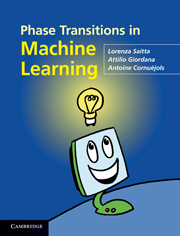Book contents
- Frontmatter
- Contents
- Preface
- Acknowledgments
- Notation
- 1 Introduction
- 2 Statistical physics and phase transitions
- 3 The satisfiability problem
- 4 Constraint satisfaction problems
- 5 Machine learning
- 6 Searching the hypothesis space
- 7 Statistical physics and machine learning
- 8 Learning, SAT, and CSP
- 9 Phase transition in FOL covering test
- 10 Phase transitions and relational learning
- 11 Phase transitions in grammatical inference
- 12 Phase transitions in complex systems
- 13 Phase transitions in natural systems
- 14 Discussion and open issues
- Appendix A Phase transitions detected in two real cases
- Appendix B An intriguing idea
- References
- Index
10 - Phase transitions and relational learning
Published online by Cambridge University Press: 05 August 2012
- Frontmatter
- Contents
- Preface
- Acknowledgments
- Notation
- 1 Introduction
- 2 Statistical physics and phase transitions
- 3 The satisfiability problem
- 4 Constraint satisfaction problems
- 5 Machine learning
- 6 Searching the hypothesis space
- 7 Statistical physics and machine learning
- 8 Learning, SAT, and CSP
- 9 Phase transition in FOL covering test
- 10 Phase transitions and relational learning
- 11 Phase transitions in grammatical inference
- 12 Phase transitions in complex systems
- 13 Phase transitions in natural systems
- 14 Discussion and open issues
- Appendix A Phase transitions detected in two real cases
- Appendix B An intriguing idea
- References
- Index
Summary
In the previous chapter we showed how the covering test in relational learning exhibits a phase transition associated with a complexity peak, for control parameter values typical of the problems investigated by current relational learners. We also showed that the complexity associated with the phase transition in matching can be partially tamed using smart search algorithms. However, as soon as the number of variables increases a little (say, from four to five) the complexity is again a strongly limiting factor for learning, because a leamer must face hundreds of thousands of matching problems during its search for hypotheses (formulas).
Leaving aside the problems caused by the computational complexity of matching, one may wonder whether the presence of a phase transition has additional effects on learning, for instance whether it affects the quality of the learned knowledge. Another question is whether it is possible to escape from the region of the phase transition by suitably manipulating the control parameters. In this chapter we try to provide an answer to these questions, by means of an experimental analysis and its interpretation.
The experimental setting
In order to test the independence of the results from the learning algorithm, we used the learners FOIL (Quinlan and Cameron-Jones, 1993), SMART + (Botta and Giordana, 1993), G-Net (Anglano et al., 1997; Anglano and Botta, 2002), and PROGOL (Muggleton, 1995) described in Chapter 6.
- Type
- Chapter
- Information
- Phase Transitions in Machine Learning , pp. 220 - 257Publisher: Cambridge University PressPrint publication year: 2011



